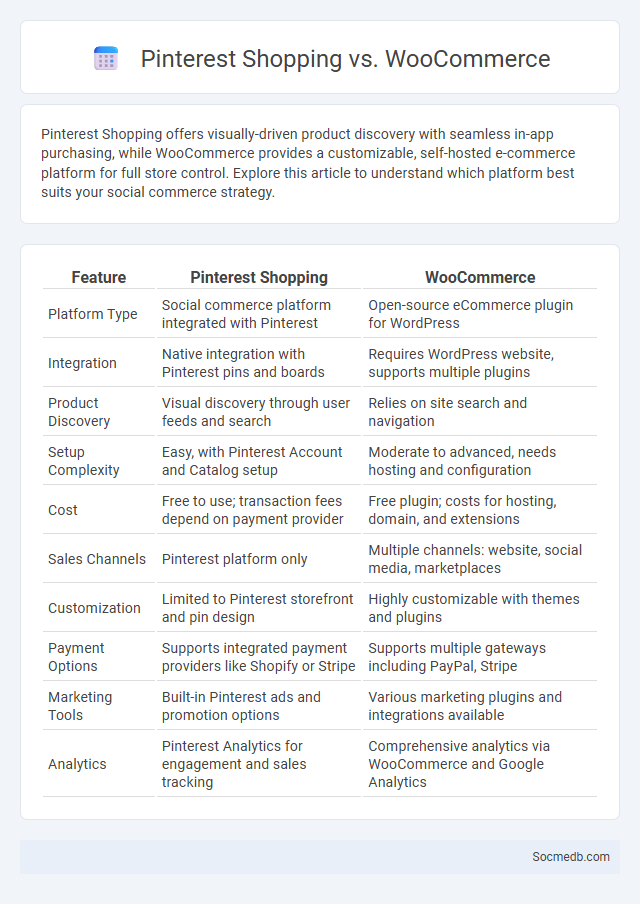
Photo illustration: Pinterest Shopping vs WooCommerce
Pinterest Shopping offers visually-driven product discovery with seamless in-app purchasing, while WooCommerce provides a customizable, self-hosted e-commerce platform for full store control. Explore this article to understand which platform best suits your social commerce strategy.
Table of Comparison
| Feature | Pinterest Shopping | WooCommerce |
|---|---|---|
| Platform Type | Social commerce platform integrated with Pinterest | Open-source eCommerce plugin for WordPress |
| Integration | Native integration with Pinterest pins and boards | Requires WordPress website, supports multiple plugins |
| Product Discovery | Visual discovery through user feeds and search | Relies on site search and navigation |
| Setup Complexity | Easy, with Pinterest Account and Catalog setup | Moderate to advanced, needs hosting and configuration |
| Cost | Free to use; transaction fees depend on payment provider | Free plugin; costs for hosting, domain, and extensions |
| Sales Channels | Pinterest platform only | Multiple channels: website, social media, marketplaces |
| Customization | Limited to Pinterest storefront and pin design | Highly customizable with themes and plugins |
| Payment Options | Supports integrated payment providers like Shopify or Stripe | Supports multiple gateways including PayPal, Stripe |
| Marketing Tools | Built-in Pinterest ads and promotion options | Various marketing plugins and integrations available |
| Analytics | Pinterest Analytics for engagement and sales tracking | Comprehensive analytics via WooCommerce and Google Analytics |
Overview of Pinterest Shopping, WooCommerce, and Shopping Integration
Pinterest Shopping transforms visual discovery into seamless e-commerce by integrating product catalogs directly within user feeds, enabling businesses to showcase inventory to a highly engaged audience. WooCommerce offers a flexible, open-source platform that empowers merchants to build customizable online stores with extensive plugin support, facilitating robust sales management. The integration between Pinterest Shopping and WooCommerce streamlines product synchronization, inventory updates, and marketing efforts, enhancing conversion rates through targeted social commerce strategies.
Key Features Comparison
Social media platforms offer diverse key features, including real-time messaging, multimedia sharing, and customizable privacy settings, which enhance user engagement and content control. Your choice depends on factors such as audience reach, algorithm transparency, and analytics tools available for monitoring performance. Evaluating features like live streaming, story formats, and advertising options helps optimize your social media strategy for maximum impact.
Ease of Setup and Use
Social media platforms are designed for effortless setup, allowing users to create accounts within minutes using minimal personal information. User-friendly interfaces and intuitive navigation tools enhance accessibility, making it simple for individuals of all technical skill levels to engage and share content. Features such as automated profile suggestions and integrated tutorials further streamline the onboarding process, ensuring a seamless user experience from the start.
Product Listing and Management
Effective product listing and management on social media platforms enhance visibility by leveraging optimized descriptions, high-quality images, and strategic use of hashtags. You can track engagement metrics and sales performance through integrated analytics tools, allowing for continuous optimization of your product catalog. Streamlined catalog management with automated updates ensures accurate stock information and pricing, improving customer trust and conversion rates.
Payment Methods and Checkout Experience
Offering diverse payment methods such as credit cards, digital wallets, and buy-now-pay-later options enhances social media shopping convenience. A streamlined checkout experience with saved payment information and one-click purchasing significantly reduces cart abandonment. Your seamless transaction process on social media platforms boosts customer satisfaction and increases conversion rates.
Marketing and Promotion Tools
Social media platforms offer powerful marketing and promotion tools designed to boost Your brand visibility and engagement. Features like targeted ads, influencer partnerships, and analytics provide precise audience insights and measurable ROI. Utilizing content scheduling and interactive posts enhances customer connection and drives sustained business growth.
Integration with Other Platforms
Seamless integration with other platforms enhances your social media strategy by allowing you to synchronize content across multiple channels like Instagram, Facebook, and Twitter. APIs and third-party tools streamline the sharing of media, analytics tracking, and audience engagement, optimizing your reach and consistency. This interconnected approach ensures your branding remains uniform and your data-driven decisions more effective.
Analytics and Reporting Capabilities
Social media analytics and reporting capabilities provide comprehensive insights into audience behavior, engagement metrics, and content performance. Advanced tools track key performance indicators (KPIs) such as reach, impressions, click-through rates, and conversion rates to optimize marketing strategies. Real-time data visualization and automated reporting facilitate timely decision-making and enhance overall social media campaign effectiveness.
Pricing and Fees Structure
Social media platforms offer various pricing and fees structures based on advertising goals, ranging from pay-per-click (PPC) to cost-per-impression (CPM) models. Your budget flexibility is enhanced by options such as daily or lifetime campaign limits, allowing precise control over spend and ROI tracking. Understanding each platform's fee transparency and targeting costs ensures efficient allocation of your social media investment.
Which Shopping Platform Is Right for Your Business?
Choosing the right shopping platform for your business depends on factors like target audience, product type, and budget. Platforms such as Shopify, BigCommerce, and WooCommerce offer customizable features and scalability for different business sizes. Evaluating your specific needs ensures you select a solution that maximizes sales and enhances customer experience on social media.
 socmedb.com
socmedb.com